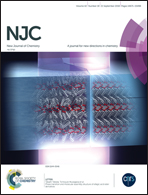Synthesis, characterization and antibacterial activity of heterocyclic quaternary ammonium polymers†
Abstract
Polymers having cationic functional groups are used as antimicrobial barriers. Commonly used cationic polymers have quaternary alkyl ammonium groups. These functional groups are heat unstable and prone to Hofmann elimination, which reduces their antimicrobial efficacy with time. To mitigate this limitation, polymers possessing heterocyclic cationic residues have been synthesized and tested for their antimicrobial activity against the dental bacterial flora. Linear and cross-linked poly(vinyl imidazole) (PVI) and poly(vinyltriazole) (PVT) with different N-alkyl chain lengths have been synthesized. The resultant polymers demonstrate antibacterial activity against the common dental bacteria Streptococcus mutans and Lactobacillus casei, as tested by a direct contact test. The antibacterial activity was additionally tested using the agar diffusion test (ADT). ADT results demonstrated no inhibition in all tested samples, showing that the antibacterial activity was by surface contact and not through diffusion. These cationic heterocyclic polymers have potential use as antimicrobial additives for dental materials that can prevent infections and secondary caries.



 Please wait while we load your content...
Please wait while we load your content...